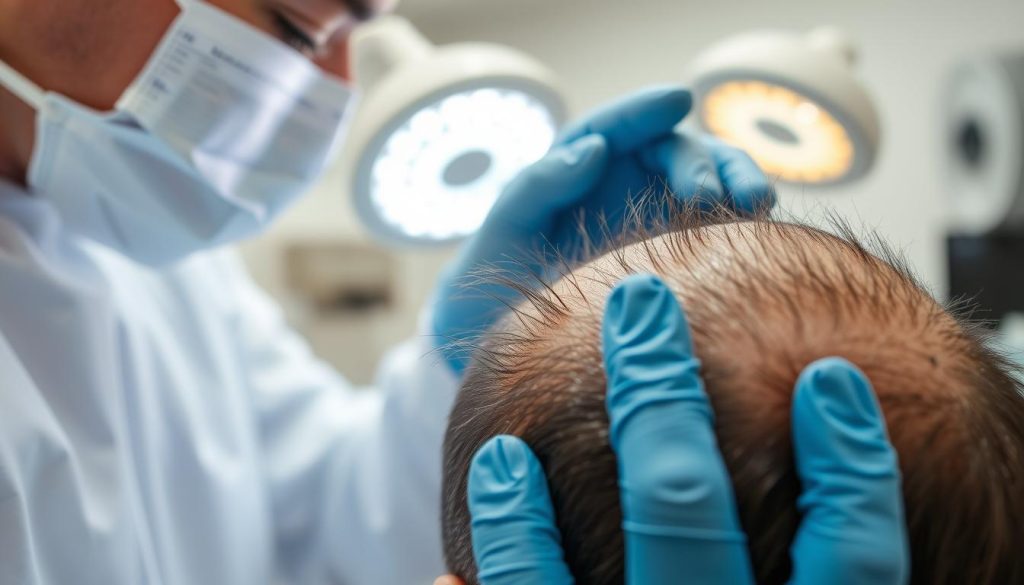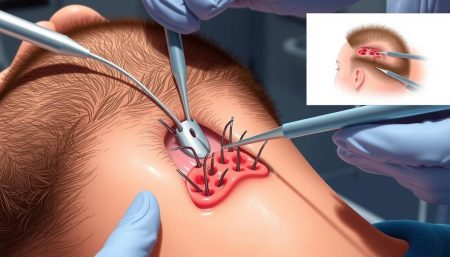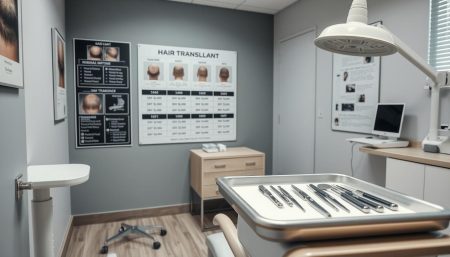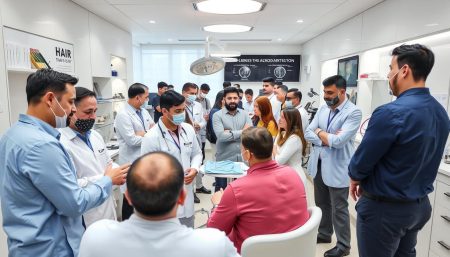Many people want to look young and full of life, and hair is a big part of that. In the US, male hair transplant is becoming more popular. It’s a way to regain lost hair and boost confidence.
These procedures are done with care and the latest technology. The best surgeons make sure each treatment is unique. It’s not just about hair; it’s about feeling good about yourself again.
Men who lose their hair often face it alone. But, there’s a supportive way to deal with it. Hair restoration for men is becoming more important. It offers new hope beyond old methods.
We’ll look at all the options available, backed by research and success stories. You’ll see how surgery can change lives. This journey shows the strength of facing challenges head-on. Let’s explore the world of male hair transplant solutions together.
Understanding Male Pattern Baldness and Hair Loss
Male pattern baldness, also known as androgenetic alopecia, is common among men. It’s caused by genetics and hormonal changes. Knowing the causes and stages helps find the best hair loss solutions for males.
The Genetics of Male Hair Loss
Genetics play a big role in male pattern baldness. Inherited genes can make hair thin and fall out. These genes make hair follicles more sensitive to DHT, a hormone that can shrink follicles and shorten the hair growth cycle.
Stages of Male Pattern Baldness
The Norwood scale helps track male pattern baldness. It goes from stage 1 (a little hair loss) to stage 7 (a lot of hair loss). Spotting these stages early is important for starting male pattern baldness treatment on time.
Psychological Impact of Hair Loss in Men
Hair loss affects men’s mental health a lot. It can lead to lower self-esteem, anxiety, and depression. It’s important to offer support and hair loss solutions for males to help with these emotional challenges.
Introduction to Male Hair Transplant
Starting the journey of men’s hair transplant surgery is a big step against male pattern baldness. This surgery not only brings back hair but also boosts self-esteem and confidence. Knowing about male hair restoration options helps people make better choices, changing how they view hair loss treatments.
Male hair transplant surgery uses different methods to meet various needs and looks. Each method takes healthy hair follicles from thick scalp areas and moves them to thin spots. This way, the transplanted hair grows naturally, making it a popular, lasting fix.
- Follicular Unit Extraction (FUE)
- Follicular Unit Transplantation (FUT)
- Direct Hair Implantation (DHI)
Deciding on these male hair restoration options means understanding their unique steps and healing times. For example, FUE has less scarring and faster healing, while FUT is better for bigger areas in fewer visits. Also, being ready emotionally and financially for men’s hair transplant surgery is key. It’s a big commitment that needs both mental and financial readiness.

Getting hair transplantation to work well in someone’s life depends a lot on the surgeon’s skill and the technology used. So, picking a certified and skilled surgeon is very important. They should know the technical side and also care about the emotional side of such big changes.
The next section will talk about the latest in hair transplant tech. It shows how new methods make surgery better and more comfortable. Keep reading to learn how these advancements can change lives, not just hair.
The Latest Techniques in Male Hair Transplant Surgery
Modern techniques in male hair transplant surgery are changing the game. They offer new hope and better results for those losing their hair. These methods not only look better but also make recovery faster and less painful.
Follicular Unit Extraction (FUE)
Follicular Unit Extraction, or FUE, removes hair follicles one by one without a big scar. This method keeps the donor area looking natural. It’s great because it leaves little to no visible marks after surgery.
Follicular Unit Transplantation (FUT)
Follicular Unit Transplantation, or FUT, takes a strip of scalp from the back of the head. Then, it’s cut into individual grafts. While it leaves a scar, it’s good for those with a lot of hair loss because it can do more grafts at once.
Robot-Assisted Hair Transplant
The robot-assisted hair transplant is the latest in hair transplant surgery. It uses robots to make the process more precise and less invasive. This means better results and less chance of mistakes.
Clincs using these new technologies are setting high standards in hair restoration. They focus on making the process safe and comfortable for patients. This is thanks to the use of robots in their procedures.
| Technique | Description | Recovery Time | Scarring |
|---|---|---|---|
| FUE | Extraction of individual hair follicles | 7-10 days | Minimal |
| FUT | Removal of a strip of scalp | 10-14 days | Linear scar |
| Robot-Assisted | High precision robotic technology | 7 days | Minimal to none |
For anyone thinking about a hair transplant, knowing the options is key. Male hair transplant clinics have the skills and tools to help you choose the right method. They make sure you get the best treatment for your needs.
Evaluating the Best Male Hair Transplant Surgeon
Finding the right surgeon is key to your hair restoration journey. This section will cover what your best male hair transplant surgeon should have. They should ensure your procedure is both effective and affordable male hair transplant.
Qualifications to Look For
When looking at surgeons, check their medical credentials and hair restoration training. A board certification in dermatology or plastic surgery is a must. It shows they’ve met high education and ethics standards. Also, being part of groups like the International Society of Hair Restoration Surgery is a plus.
Importance of Experience and Gallery of Results
Experience is vital for a hair transplant surgeon’s skill. A big portfolio of successful cases shows their ability to meet different needs. Look at before and after photos to see if the results look natural and effective.
Also, read what past clients say about the surgeon. Their feedback can tell you a lot about the surgeon’s reliability and quality. This helps you find a good affordable male hair transplant without sacrificing quality.
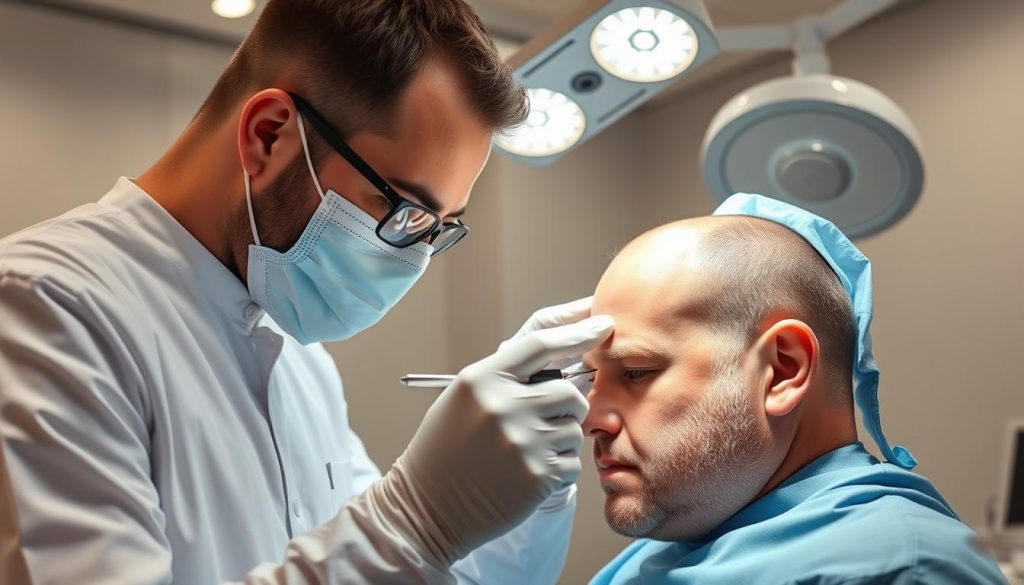
What to Expect from Men’s Hair Transplant Surgery
Choosing men’s hair transplant surgery is a big step. It’s about getting back hair density and feeling confident again. Here’s what you might see from start to finish, from planning to seeing the male hair transplant before and after results.
- Pre-Surgery Consultation: This first meeting with your surgeon is key. It’s where you set goals and talk about your hair loss. You can also discuss any health issues and plan your hairline and density.
- The Day of the Surgery: The surgery is done under local anesthesia. It can take a few hours, but you’ll be relaxed during that time.
- Recovery Period: After surgery, you might feel a bit sore. But the care is easy, and you’ll be told how to heal best.
- Timeline of Hair Growth: You’ll start to see hair growth in a few months. But it takes about 9-12 months to see the full male hair transplant before and after effect.
Knowing what to expect helps you prepare for the journey. Here’s a table to show how hair grows after surgery.
| Timeframe | Expected Progress |
|---|---|
| 1-3 Months | Initial hair shedding followed by the emergence of new growth |
| 4-6 Months | Noticeable hair growth in transplant areas |
| 7-9 Months | Increased density and maturation of hair texture |
| 10-12 Months | Full, natural-looking hair density and appearance |
This timeline is a general guide. Results can vary based on health, hair loss, and surgery method. Talking openly with your surgeon about men’s hair transplant surgery can make you happier with the results.
Male Hair Restoration Options Beyond Transplants
Hair transplant surgery is just one way to fight male pattern baldness. There are many non-surgical options that offer lasting hair loss solutions for males. These options show the need for a personalized approach in male pattern baldness treatment.
Medical Treatments for Hair Loss
FDA-approved drugs like Minoxidil and Finasteride are key in treating hair loss. They either boost hair growth or stop it from falling out. These drugs are great for early baldness, helping to keep or even grow hair.
Non-Surgical Hair Replacement Systems
New hair technology has led to advanced non-surgical hair systems. These include hairpieces and toupees that look and feel natural. They offer a quick fix to hair loss without surgery. Plus, they can match your style and hair color perfectly.
Laser Therapy for Hair Regrowth
Laser therapy uses low-level lasers to help hair grow. It’s approved by the FDA and boosts blood flow in the scalp. This method is painless and can be used with other treatments to fight hair loss.

Looking into these hair loss solutions for males can help those with male pattern baldness. It shows there are many ways to restore hair without surgery.
Maximizing Results: Post-Transplant Hair Care
Getting the most out of a male hair transplant is not just about the surgery. It’s also about the care you give your scalp after. How well you take care of your scalp after surgery can make a big difference in the success of your transplant.
Following the aftercare plan your surgeon gives you is key. It helps your scalp heal right and makes your transplant look better.
- Immediate Care Post-Surgery: Right after the surgery, it is important to follow your surgeon’s advice. Avoid activities that might stress your scalp or mess with the healing.
- Washing and Treating the Hair: You’ll get specific tips on washing and caring for your hair right after the transplant. Use gentle, recommended products to keep your scalp calm.
- Maintaining a Healthy Diet: Eating foods rich in nutrients helps your hair grow and keeps the new follicles strong.
Regular check-ups with your surgeon are also important. They help make sure your recovery is going well and keep an eye on the health of your new hair.
Long-term care is just as important. Protect your scalp from too much sun, stay away from harsh chemicals, and keep your hair care gentle. Getting hair treatments from a trichologist can also help keep your transplant looking good for longer.
By sticking to these tips, you can make sure your hair transplant is a success. This way, you’ll get the most out of your investment in hair restoration for men.
Male Hair Transplant Clinic: Choosing the Right One
Finding a male hair transplant clinic can be tough. Each clinic claims to have the best results. It’s important to know what makes one stand out from the rest. We’ll show you how to pick a clinic that meets your male hair restoration options needs.
Factors to Consider When Choosing a Clinic
Choosing the right hair restoration clinic is more than just location. Key factors should guide your choice:
- Reputation: Look at patient reviews and before-and-after photos to see real results.
- Technology: The latest technology shows a clinic’s dedication to top-notch treatments.
- Experience: Choose clinics with experienced specialists in hair transplantation.
Consultation Process and Patient Education
The consultation process is also important. A great male hair transplant clinic will offer a detailed consultation. This includes:
- Tailored Evaluations: A thorough scalp and hair analysis to fit the treatment to your needs.
- Transparent Communication: Clear talks about what to expect, recovery times, and risks.
- Educational Support: Giving you all the info on surgical and non-surgical male hair restoration options to help you decide.
Choosing the right clinic is about more than just the surgery. It’s about feeling informed, comfortable, and confident on your hair restoration journey.
Affordable Male Hair Transplant Procedures
Understanding the cost of hair restoration is key for those looking for affordable male hair transplant options. The demand for hair loss solutions for males has led to various pricing strategies. This section will look at cost-effective hair transplant procedures, payment plans, and financing options.
When evaluating the cost of hair transplant procedures, several factors come into play. These include the technique used, the location, and the surgeon’s experience. It’s important for those considering treatment to know how these factors affect the cost and quality.
- Financing Options: Many clinics offer financing plans that make treatment more accessible by allowing payments over time.
- Geographical Variations: Costs can vary significantly from one region to another, presenting opportunities for cost savings depending on the location.
- Technological Advances: Innovative procedures might be more cost-effective in the long run due to their efficiency and reduced recovery times.
| Country | Average Cost | Financing Available |
|---|---|---|
| USA | $6,000 – $15,000 | Yes |
| Canada | $4,000 – $12,000 | Yes |
| Mexico | $2,500 – $6,000 | No |
The search for an affordable male hair transplant continues to grow. The field offers many options, ensuring most budgets can find a match. It’s vital for those considering these procedures to research thoroughly and understand all financial aspects before making a decision.
Comparing Traditional and Emerging Hair Loss Solutions for Males
The world of hair restoration for men is changing fast. Old surgical methods are now joined by new ways from regenerative medicine and drugs. This part talks about how these new ideas are changing things and giving hope to those losing their hair.
The Role of Regenerative Medicine in Hair Restoration
Regenerative medicine is taking male hair transplant advancements to new levels. Stem cell therapy is very promising. It uses the body’s own cells to make hair grow on the scalp.
By putting these powerful cells in the right places, men are seeing hair come back. This was not possible with old methods alone.
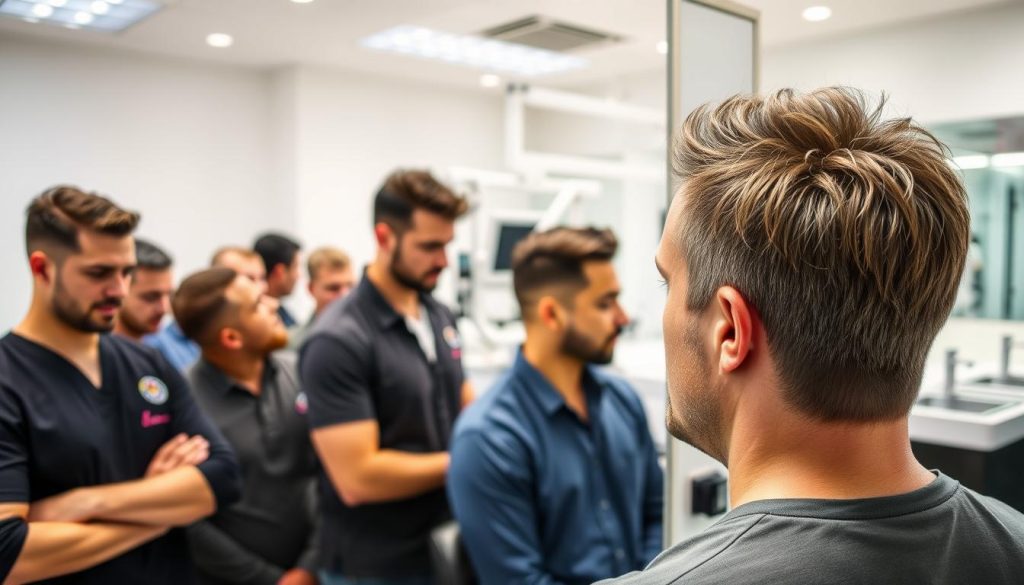
The Future of Hair Growth Pharmaceuticals
The drug world is also moving forward. New medicines are being made to fight the genetic causes of baldness in men. These drugs stop hair loss and help new hair grow.
They offer a way to fix hair loss without surgery. This is good news for those who don’t want to go under the knife.
Both old and new hair restoration for men ways have their place. But, the mix of stem cell therapy and special drugs is setting a new standard. As research goes on, we’ll see more ways to treat hair loss completely. This could start a new chapter in taking care of hair health.
Real Stories: Male Hair Transplant Before and After
The journey through male hair restoration is deeply personal and life-changing. Male hair transplant before and after photos show the amazing changes. They also share the stories of those who found new confidence and self-worth.
Male hair restoration success stories start with the struggle of hair loss. Then, comes the bold choice to get a hair transplant. The results are not just in how they look but also in how they feel about themselves.
- First, there are detailed consultations to create a plan just for them.
- The surgery is described as professional and supportive.
- These stories follow the journey of hair growth and change.
Each story is a ray of hope for those thinking about male hair transplant and restoration. They show that with the right care, big changes can happen. These stories touch on the emotional and mental benefits of a successful hair restoration.
Planning for Long-Term Success with Male Hair Restoration
After a male hair transplant, the journey to keep your hair healthy goes on. It’s not just about the surgery. You need a plan that includes medical care, lifestyle changes, and regular check-ups. Working with your healthcare team and taking good care of your hair is key to success.

A good plan is vital for keeping your hair looking great. It’s not just about the first treatment. You also need to watch out for things that can affect your hair’s health.
- Diet and nutrition
- Stress management
- Scalp care
- Regular check-ups with a hair restoration specialist
By following these steps, you can keep your hair looking fuller and healthier for a long time.
| Component | Importance | Recommended Actions |
|---|---|---|
| Diet | High | Eat foods rich in protein and vitamins that help hair grow. |
| Stress Management | Medium | Do regular exercise and practice mindfulness. |
| Scalp Care | High | Use gentle, sulfate-free shampoos and avoid harsh chemicals. |
| Regular Check-Ups | Essential | See a hair specialist every six months to check on your transplant. |
Keeping your male hair transplant looking good is a long-term effort. It takes time and effort. With the right long-term hair restoration planning, you can keep and even improve your hair’s look over time.
Risks and Complications Associated with Male Hair Transplant
Hair restoration for men comes with risks that need careful thought. Advances in hair transplant surgery have made it safer and more effective. Yet, it’s important to know the possible downsides.
Infection is a rare but possible risk, thanks to strict cleanliness during surgery. Scarring is also a concern, even with modern methods like FUE. Those prone to keloid scars or choosing FUT should be extra cautious.
The look of the hair after surgery is another big worry. If not done right, it might look unnatural. A skilled surgeon is key to getting a natural-looking hairline and growth.
Temporary side effects like swelling and numbness can happen. Proper care after surgery is vital to avoid these issues. It’s also important to have realistic expectations about the outcome.
Choosing a board-certified surgeon with a good track record can greatly improve safety. Their expertise is critical in reducing risks and ensuring success. Following the doctor’s advice on aftercare is essential for the best results.
FAQ
Q: What are the most effective male hair transplant solutions available in the US?
A: In the US, the top hair transplant options for men are Follicular Unit Extraction (FUE) and Follicular Unit Transplantation (FUT). These are done by top surgeons using the latest methods for natural-looking hair.
Q: How is male pattern baldness treated?
A: Male pattern baldness is mainly treated with hair transplant surgery. Other options include Minoxidil and Finasteride, laser therapy, and non-surgical hair systems.
Q: What factors contribute to hair loss in men?
A: Men lose hair due to genetics, hormonal imbalances, nutritional issues, stress, and some medical conditions.
Q: What should I look for when choosing the best male hair transplant surgeon?
A: Look for a surgeon’s qualifications, training, and experience. Also, check their before and after photos. Choose a surgeon who offers quality care at a good price.
Q: How long is the recovery period after men’s hair transplant surgery?
A: Recovery time varies, but most can go back to normal in a few days. Full healing and hair growth takes months to a year.
Q: Are there male hair restoration options beside transplant surgery?
A: Yes, there are non-surgical options like Minoxidil and Finasteride, laser therapy, and non-surgical hair systems.
Q: What post-transplant hair care is recommended to maximize results?
A: Follow your surgeon’s aftercare advice, use the right products, and make lifestyle changes to support hair growth.
Q: How do I choose the right male hair transplant clinic?
A: Consider the clinic’s reputation, technology, team experience, and patient education and aftercare services.
Q: How can I find an affordable male hair transplant procedure?
A: Look for prices, payment plans, and consider locations where costs might be lower.
Q: What advancements are emerging in the treatment of male hair loss?
A: New treatments include stem cell therapies and innovative drugs to improve hair restoration.
Q: Can I see real examples of male hair transplant before and after results?
A: Yes, clinics and surgeons show before and after photos to prove their skills and the procedure’s effects.
Q: What long-term planning is necessary for male hair restoration success?
A: Plan for long-term success with a hair care routine, positive lifestyle, stress management, and regular check-ups.
Q: What are the risks and complications associated with male hair transplant surgery?
A: Risks include infection, scarring, and unnatural hairlines. Choose a qualified surgeon, follow aftercare, and manage expectations.












